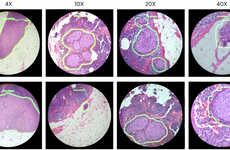
Researchers Focus on Zebrafish
Michael Plishka — October 11, 2008 — Eco
References: embl-heidelberg.de & embl.de
Imagine sitting in space and looking at Earth through a telescope. You narrow in on one lake in North Dakota that contains 15,000 fish. Your job is to track the movements of each fish for an entire day. Sounds like an impossibility, doesn't it?
However, at the European Molecular Biology Laboratory [EMBL], researchers there have accomplished just this, using a newly developed a Digital Scanned Laser Light Sheet Microscope and a large-scale computing pipeline located at the Karlsruhe Institute of Technology.
Well, not exactly, but for the first time researchers have followed the growth of each cell in a zebrafish embryo as it grew from one to 20,000 cells strong.
By taking over 400,000 images per embryo, researchers can locate each cell's movement as it comes into existence. As researcher Jochen Wittbrodt points out, "The digital embryo is like Google Earth™ for embryonic development. It gives an overview of everything that happens in the first 24 hours and allows you to zoom in on all cellular and even subcellular details."
As research continues and this technique is used on other vertebrates, science's fundamental knowledge of embryonic development and evolution will be expanded and challenged.
Other videos are available here.
However, at the European Molecular Biology Laboratory [EMBL], researchers there have accomplished just this, using a newly developed a Digital Scanned Laser Light Sheet Microscope and a large-scale computing pipeline located at the Karlsruhe Institute of Technology.
Well, not exactly, but for the first time researchers have followed the growth of each cell in a zebrafish embryo as it grew from one to 20,000 cells strong.
By taking over 400,000 images per embryo, researchers can locate each cell's movement as it comes into existence. As researcher Jochen Wittbrodt points out, "The digital embryo is like Google Earth™ for embryonic development. It gives an overview of everything that happens in the first 24 hours and allows you to zoom in on all cellular and even subcellular details."
As research continues and this technique is used on other vertebrates, science's fundamental knowledge of embryonic development and evolution will be expanded and challenged.
Other videos are available here.
Trend Themes
1. Digital Scanned Laser Light Sheet Microscope - Disruptive innovation opportunity: Advancements in imaging technology for detailed cellular analysis in various industries such as medical research and diagnostics.
2. Embryonic Development - Disruptive innovation opportunity: Revolutionary insights into embryonic development can lead to breakthroughs in regenerative medicine and genetic research.
3. Large-scale Computing Pipeline - Disruptive innovation opportunity: Development of powerful computing systems to process and analyze massive amounts of data can be applied in industries such as artificial intelligence and big data analytics.
Industry Implications
1. Medical Research - Disruptive innovation opportunity: Applying advanced imaging techniques and data analysis to study embryonic development can transform our understanding of diseases and inform new treatment approaches.
2. Diagnostics - Disruptive innovation opportunity: Improved imaging technology and data-driven analysis can revolutionize the accuracy and efficiency of diagnostic processes in healthcare.
3. Regenerative Medicine - Disruptive innovation opportunity: Deeper insights into embryonic development can accelerate the research and development of regenerative therapies for various medical conditions.
2.7
Score
Popularity
Activity
Freshness















